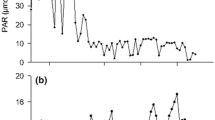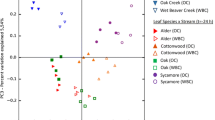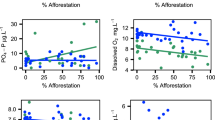Abstract
Bacteria attached to rock and glass surfaces were studied in streams draining a whole-tree harvested watershed (WTH) and a nonharvested (CONTROL) watershed in the Hubbard Brook Experimental Forest, New Hampshire, U.S.A. Seasonal trends in numbers of cells/cm2, mean cell volume, cell size-frequency distribution, and bacterial biomass were determined using 4′6-diamidino-2-phenylindole (DAPI) epifluorescent microscopy and scanning electron microscopy (SEM); the response of these parameters to decreased pH and increased nitrate concentration in the WTH stream was assessed via controlled manipulation of stream water chemistry in artificial channels placed in the CONTROL stream. Bacterial distribution varied significantly between the two streams and seasonally within each stream in apparent response to differential availability of dissolved organic carbon from algae and autumn-shed leaves. Decreased pH similar to that in the WTH stream had a significant effect on cell numbers, mean cell volume, and biomass in the CONTROL stream. Decreased pH accounted for some aspects of the altered bacterial distributions observed in the WTH stream. Nitrate at concentrations similar to those in the WTH stream had no effect on bacterial distribution in the CONTROL stream suggesting that headwater stream epilithic bacteria were carbon limited.
Similar content being viewed by others
References
APHA (American Public Health Association) (1981) Standard methods for the examination of water and wastewater, 15th ed.
Baath E, Lundgren B, Soderstrom B (1979) Effects of artificial acid rain on microbial activity and biomass. Bull Environm Contam Toxicol 23:737–740
Baker MD, Iniss WE, Mayfield CI, Wong PTS (1982) Effect of pH on the growth and activity of heterotrophic sediment microorganisms. Chemosphere 11:973–983
Bell CR, Holder-Franklin MA, Franklin M (1982) Seasonal fluctuations in river bacteria as measured by multivariate statistical analysis of continuous cultures. Can J Microbiol 28:959–975
Bewley RJF, Stotzky G (1983) Simulated acid rain (H2SO4) and microbial activity in soil. Soil Biol Biochem. 15:425–429
Bilby RE (1981) Role of organic debris dams in regulating the export of dissolved and particulate organic matter from a forested watershed. Ecology 62:1234–1243
Bilby RE, Likens GE (1979) Effect of hydrologic fluctuations on the transport of fine particulate organic carbon in a small stream. Limnol Oceanogr 24:69–75
Bormann FH, Likens GE (1979) Pattern and process in a forested ecosystem. Springer-Verlag, New York
Bormann FH, Likens GE, Siccama TG, Pierce RS, Eaton JS (1974) The export of nutrients and the recovery of stable conditions following deforestation at Hubbard Brook. Ecol Monogr 44:255–277
Bott TL, Kaplan LA, Kuserk FT (1984) Benthic bacterial biomass supported by streamwater dissolved organic matter. Microb Ecol 10:335–344
Bratbak G (1985) Bacterial biovolume and biomass estimations. Appl Environ Microbiol 49:1488–1493
Burton TM, Likens GE (1973) The effects of strip-cutting on stream temperatures in the Hubbard Brook Experimental Forest, New Hampshire. Bioscience 23:433–435
Dahm CN (1981) Pathways and mechanisms for removal of dissolved organic carbon from leaf leachate in streams. Can J Fish Aquat Sci 38:68–76
Ferroni GD, Leduc LG, Choquet CG (1983) Preliminary studies on the use of the heterotrophic activity method to evaluate acid-stress effects in aquatic environments. Water Res 17:1379–1384
Fisher SG, Likens GE (1973) Energy flow in Bear Brook, New Hampshire: an integrative approach to stream metabolism. Ecol Monogr 43:421–438
Geesey GG, Mutch R, Costerton JW (1978) Sessile bacteria: an important component of the microbial population in small mountain streams. Limnol Oceanogr 23:1214–1223
Haack TK, McFeters GA (1982a) Microbial dynamics of an epilithic mat community in a high alpine stream. Appl Environ Microbiol 43:702–707
Haack TK, McFeters GA (1982b) Nutritional relationships among microorganisms in an epilithic biofilm community. Microb Ecol 8:115–126
Hamilton PB, Duthie HC (1984) Periphyton colonization of rock surfaces in a boreal forest stream studied by scanning electron microscopy and track autoradiography. J Phycol 20:525–532
Hawkins CP, Murphy ML, Anderson NH (1982) Effects of canopy, substrate composition, and gradient on the structure of macroinvertebrate communities in Cascade Range streams in Oregon. Ecology 63:1840–1856
Kaplan LA, Bott TL (1982) Diel fluctuations of DOC generated by algae in a piedmont stream Limnol Oceanogr 27:1091–1100
Kaplan LA, Bott TL (1983) Microbial heterotrophic utilization of dissolved organic matter in a piedmont stream. Freshw Biol 13:363–377
Korte VL, Blinn DW (1983) Diatom colonization on artificial substrata in pool and riffle zones studied by light and scanning electron microscopy. J Phycol 19:332–341
Kuserk FT, Kaplan LA, Bott TL (1984) In situ measures of dissolved organic carbon flux in a rural stream. Can J Fish Aquat Sci 41:964–973
Likens GE, Bormann FH, Johnson NM, Fisher DW, Pierce RS (1970) Effects of forest cutting and herbicide treatment on nutrient budgets in the Hubbard Brook watershed-ecosystem. Ecol Monogr 40:23–47
Likens GE, Bormann FH, Pierce RS, Eaton JS, Johnson NM (1977) Biogeochemistry of a forested ecosystem. Springer-Verlag, New York
Lock MA (1981) River epilithon—a light and organic energy transducer. In: Lock MA, Williams DD (eds) Perspectives in running water ecology. Plenum Press, New York, pp 3–40
Martin CW, Noel DS, Federer AC (1984) Effects of forest clearcutting in New England on stream chemistry. J Environ Qual 13:204–210
McArthur JV, Marzolf GR, Urban JE (1985) Response of bacteria isolated from a pristine prairie stream to concentration and source of soluble organic carbon. Appl Environ Microbiol 49:238–241
McDowell WH (1984) Temporal changes in numbers of suspended bacteria in a small woodland stream. Verh Internat Verein Limnol 22:1920–1925
McDowell WH, Wood T (1984) Podzolization: soil processes control dissolved organic carbon concentrations in stream water. Soil Sci 137:23–32
Meyer JL (1979) The role of sediments and bryophytes in phosphorous dynamics in a headwater stream ecosystem. Limnol Oceanogr 24:365–375
Meyer JL (1980) Dynamics of phosphorous and organic matter during leaf decomposition in a forest stream. Oikos 34:44–53
Meyer JL, Likens GE, Sloane J (1981) Phosphorous, nitrogen and organic carbon flux in a headwater stream. Arch Hydrobiol. 91:28–44
Naiman RJ (1982) Characteristics of sediment and organic carbon export from pristine boreal forest watersheds. Can J Fish Aquat Sci 39:1699–1718
Padan E (1984) Adaptation of bacteria to external pH. In: Klug MJ, Reddy CA (eds) Current perspectives in microbial ecology. American Society for Microbiology, Washington DC, PP 49–55
Porter KG, Feig YS (1980) The use of DAPI for identifying and counting aquatic microflora. Limnol Oceanogr 25:943–948
Rao SS, Jurkovic AA, Nriagu JO (1984) Bacterial activity in sediments of lakes receiving acid precipitation. Environ Poll (Ser A) 36:195–205
Rao SS, Paolini D, Leppard GG (1984) Effects of low-pH stress on the morphology and activity of bacteria from lakes receiving acid precipitation. Hydrobiol 114:115–121
Richey JS, McDowel WH, Likens GE (1985) Nitrogen transformations in a small mountain stream. Hydrobiol 124:129–139
Rounick JS, Winterbourn MJ (1983) The formation, structure and utilization of stone surface organic layers in two New Zealand streams. Freshw Biol 13:57–72
Rounick JS, Winterbourn MJ, Lyon GL (1982) Differential utilization of allochthonous and autochthonous inputs by aquatic invertebrates in some New Zealand streams: a stable carbon isotope study. Oikos 39:191–198
Smibert RM, Krieg NR (1981) General characterization. In: Gerhardt P (ed) Manual of methods for general bacteriology, American Society for Microbiology, Washington, DC, pp 409–443
Vitousek PM, Mellilo JM (1979) Nitrate losses from disturbed forests: patterns and mechanisms. For Sci 25:605–619
Webster JR, Waide JB (1982) Effects of forest clearcutting on leaf breakdown in a southern Appalachian stream. Freshw Biol 12:331–344
Author information
Authors and Affiliations
Rights and permissions
About this article
Cite this article
Haack, S.K., Burton, T. & Ulrich, K. Effects of whole-tree harvest on epilithic bacterial populations in headwater streams. Microb Ecol 16, 165–181 (1988). https://doi.org/10.1007/BF02018912
Issue Date:
DOI: https://doi.org/10.1007/BF02018912




